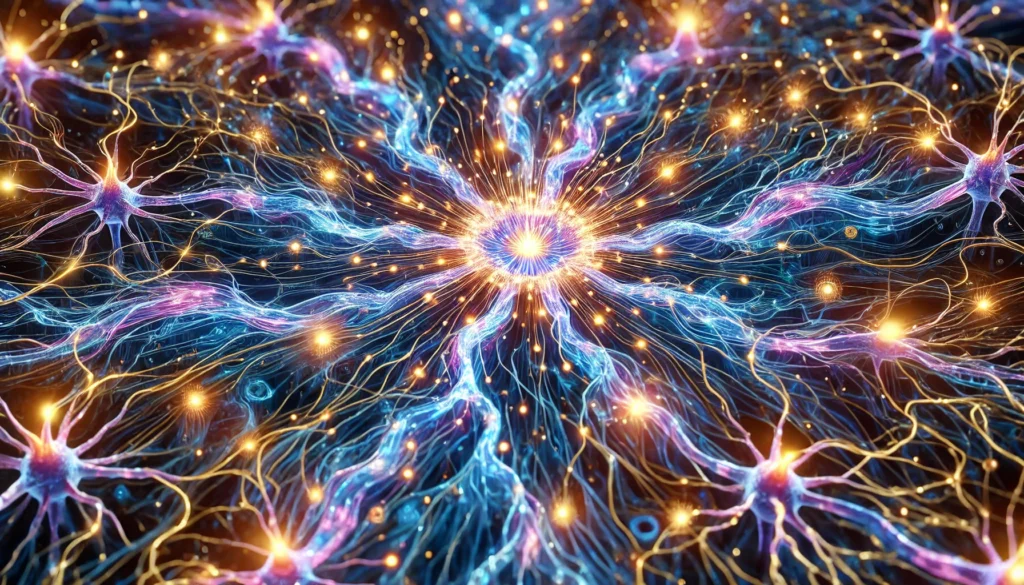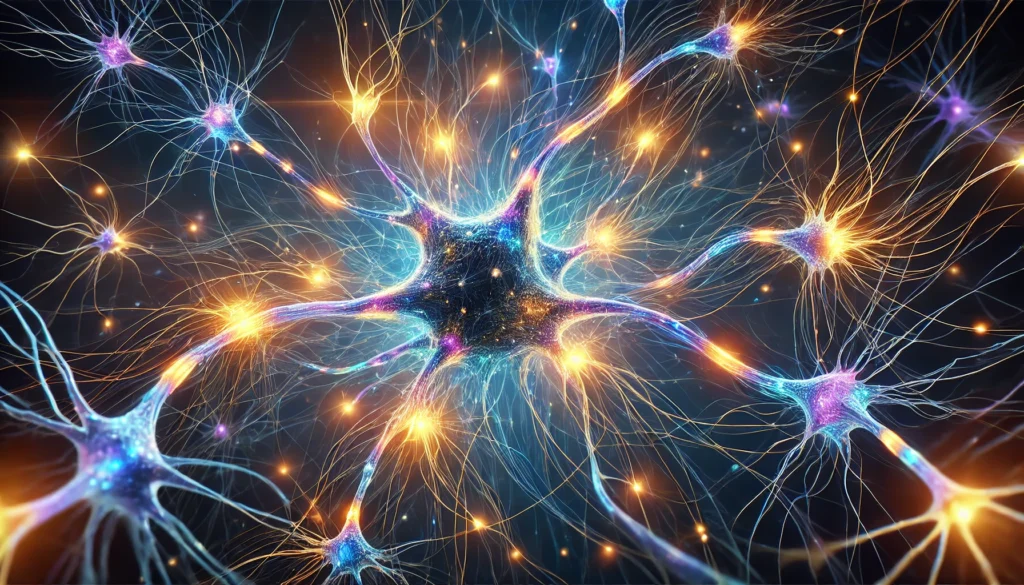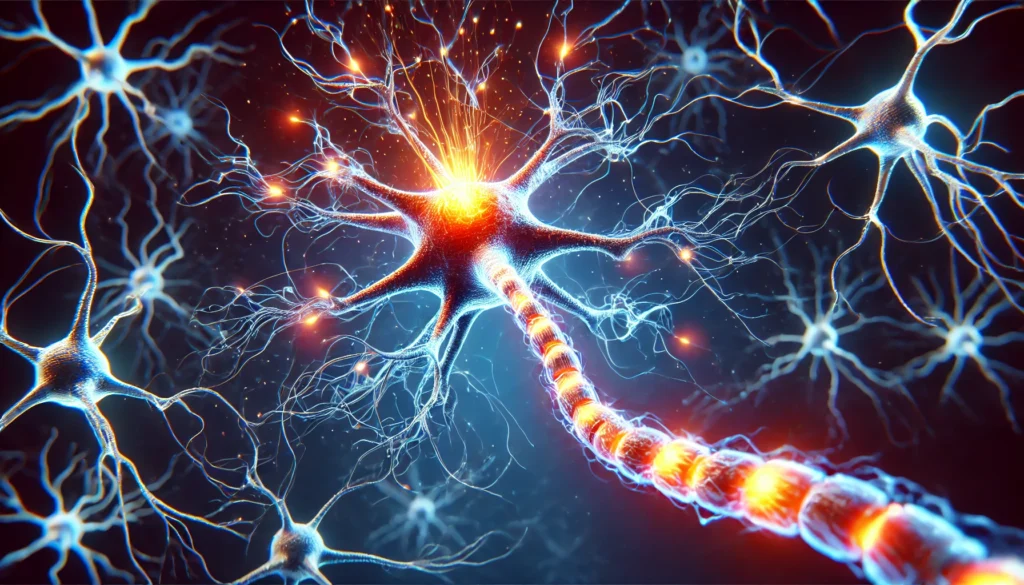The human brain is an intricate and dynamic organ, constantly adapting and refining its network of connections. At the heart of cognitive function, learning, and memory lies the fundamental process of neuron firing. Understanding what happens when a neuron fires provides critical insights into neural pathway strengthening, which is essential for improving memory and recall. This article delves into the electrochemical action of a neuron, the role of action potentials, and how neuroplasticity supports cognitive function, all while exploring practical ways to enhance neural connectivity for optimal brain health.
You may also like: How to Increase Neuroplasticity: Strengthening Neural Pathways for Better Memory & Recall
The Process of Neuron Firing: An Overview
A neuron fires when it transmits an electrical signal along its axon to communicate with other neurons, a process essential for cognitive function. The journey begins with the resting potential, during which the neuron maintains a negative charge inside relative to the outside environment. When the neuron receives sufficient stimuli, the resting potential shifts, initiating a cascade of events leading to an action potential. This rapid depolarization and repolarization process enables the neuron to transmit signals efficiently.
The action potential follows a well-defined sequence: the resting state, depolarization, repolarization, and the return to resting potential. These steps ensure that electrical impulses travel effectively along the axon to reach the next neuron. Understanding the action potential step by step provides deeper insight into how neurons communicate and how neural pathways strengthen with repeated activity.

The Electrochemical Action of a Neuron: Generating an Action Potential
The firing of a neuron is fundamentally an electrochemical process, relying on the movement of ions across the neuronal membrane. When a neuron receives input from other neurons, ion channels open, allowing positively charged sodium ions to flow inside the cell. This influx of ions depolarizes the neuron, bringing it closer to the threshold required to trigger an action potential. Once the threshold is reached, voltage-gated sodium channels open, causing a rapid spike in voltage as the neuron becomes momentarily positive relative to its surroundings.
As the peak voltage is reached, sodium channels close, and potassium channels open, allowing potassium ions to exit the neuron. This repolarization phase restores the negative charge inside the neuron, preparing it for another potential firing. The entire sequence ensures that action potentials move along axons in a unidirectional manner, efficiently transmitting information throughout the nervous system.
The Role of Action Potential in Neural Communication
Neurons rely on action potentials to communicate with one another, forming the basis of thought, perception, and memory. When a neuronal action potential reaches the axon terminal, neurotransmitters are released into the synaptic cleft. These chemical messengers bind to receptors on the receiving neuron, continuing the chain of communication.
Neural plasticity plays a significant role in refining these connections. When specific neural pathways are repeatedly activated, synaptic strength increases, leading to more efficient communication. This process, known as long-term potentiation, is essential for memory formation and recall. By strengthening neural pathways through repeated use, individuals can enhance cognitive function and improve their ability to retain and retrieve information.
Strengthening Neural Pathways for Enhanced Memory and Recall
Neuroplasticity, or the brain’s ability to adapt and reorganize itself, is the key to strengthening neural pathways. Various strategies can promote neuroplastic changes, ultimately improving memory and recall. One of the most effective methods is engaging in regular cognitive exercises, such as learning new skills, solving complex problems, and practicing mindfulness techniques.
Physical activity also plays a crucial role in enhancing neuroplasticity. Exercise increases blood flow to the brain, promoting the release of neurotrophic factors that support neuron growth and survival. Additionally, a balanced diet rich in omega-3 fatty acids, antioxidants, and essential nutrients supports brain health, ensuring optimal neuronal function.
Quality sleep is another vital component of neural pathway strengthening. During sleep, the brain consolidates memories and eliminates unnecessary information, refining neural connections. Establishing a consistent sleep schedule and minimizing disruptions can significantly enhance cognitive performance.

Frequently Asked Questions (FAQ) on Neuron Firing and Neural Pathway Strengthening
1. What determines whether a neuron has an action potential? A neuron fires an action potential only if it reaches a specific threshold potential, which is dictated by the sum of excitatory and inhibitory signals it receives. If the excitatory signals surpass the inhibitory ones, the neuron depolarizes enough to trigger an action potential. Factors such as ion channel density, neurotransmitter concentration, and synaptic activity contribute to this threshold. Additionally, external influences like drugs, diet, and physical activity can alter neuronal excitability, affecting the likelihood of an action potential. By studying the action potential graph, researchers can analyze the specific voltage changes that occur during neural signaling.
2. What happens when a neuron fires in terms of communication with other neurons? When a neuron fires, it sends an electrical impulse down its axon, which ultimately leads to the release of neurotransmitters at the synapse. These chemical messengers cross the synaptic cleft and bind to receptors on a neighboring neuron, influencing its potential to fire. This neuron communication, resting potential, and action potential hexagons provide a systematic way to illustrate how neurons connect and transmit signals. Strengthening these connections through learning and repetition enhances memory and recall. The efficiency of this process determines cognitive agility and neural adaptability over time.
3. How does the action potential move along the axon? Action potentials move along axons through a regenerative process known as saltatory conduction in myelinated neurons and continuous conduction in unmyelinated neurons. Myelin sheaths allow action potentials to jump between nodes of Ranvier, significantly increasing transmission speed. Without myelin, the action potential propagates more slowly, which can lead to cognitive impairments in diseases like multiple sclerosis. The events in action potential propagation involve sequential depolarization and repolarization along the axon membrane. The efficiency of conduction influences reaction time and information processing capabilities.
4. What is the typical duration of a nerve action potential? The duration of a nerve action potential varies depending on the type of neuron but generally lasts between one and two milliseconds. This rapid process allows neurons to fire at high frequencies, which is essential for processing complex information quickly. Action potential step by step analysis reveals that while the duration remains brief, the refractory period following an action potential ensures that the neuron resets properly before firing again. Some specialized neurons, like those in the auditory system, have even shorter action potentials to facilitate rapid sensory processing. Understanding these dynamics helps neuroscientists develop treatments for neurological disorders affecting signal transmission.
5. What causes a neuron to fire and how can it be influenced? A neuron fires when it receives sufficient excitatory input to reach its threshold potential, triggering an action potential. This process can be influenced by synaptic plasticity, which strengthens or weakens neural connections based on experience and learning. Environmental factors such as stress, sleep, and nutrition also impact neuronal firing patterns. Within a single neuron, the action potential depends on the balance of sodium and potassium ion movement across the membrane. Research into neuronal excitability helps inform cognitive enhancement strategies and therapeutic interventions for memory loss.
6. What keeps an action potential continuing down an axon? Once initiated, an action potential is self-propagating due to the opening of voltage-gated sodium channels along the axon. This sequential activation ensures that the signal moves unidirectionally toward the axon terminal. Myelination enhances this process by insulating the axon and allowing for faster conduction of action potentials along axons. In demyelinating diseases, signal propagation is disrupted, leading to cognitive deficits and motor impairments. Understanding how to maintain healthy axonal conduction is crucial for preventing neurodegenerative conditions.
7. Why do neurons generate an action potential instead of using direct chemical transmission? Neurons rely on action potentials because electrical signals can travel long distances with high fidelity, unlike chemical signals that diffuse more slowly. The neuron and neural firing process ensures rapid information relay across vast neural networks. While neurotransmitters are essential for synaptic communication, the electrical impulse itself guarantees signal reliability over extended pathways. This hybrid system allows for the complexity of brain function, integrating both electrical and chemical modes of transmission. Future research may explore bioengineering approaches to enhance neural communication artificially.
8. Do dendrites conduct action potentials or only axons? Dendrites primarily receive and integrate synaptic inputs rather than conduct action potentials. However, under certain conditions, dendritic action potentials can occur, influencing neuronal plasticity and learning. This phenomenon, known as backpropagation, can modulate synaptic strength and contribute to long-term memory formation. Action potentials normally travel along an axon rather than dendrites due to the higher concentration of voltage-gated sodium channels in axonal membranes. The role of dendrites in signal processing highlights the complexity of neural computation beyond simple electrical transmission.
9. What happens when neuronal action potential reaches the axon terminal? When neuronal action potential reaches the axon terminal of neuron 1, it triggers the opening of voltage-gated calcium channels. The influx of calcium ions prompts the release of neurotransmitters into the synaptic cleft, facilitating communication with the next neuron. This step is crucial for maintaining synaptic efficiency and neural network stability. Dysfunctions in this process can result in neurological conditions such as epilepsy or neurodegenerative diseases. Understanding the precise mechanisms of neurotransmitter release is vital for developing targeted drug therapies.
10. How does neural pathway strengthening improve memory and recall? Neural pathway strengthening enhances memory and recall by reinforcing synaptic connections through repeated activation. This process, known as synaptic plasticity, involves biochemical changes that make neural communication more efficient over time. Techniques such as cognitive training, meditation, and physical exercise have been shown to promote neuroplasticity and improve cognitive function. By optimizing neuron firing steps and the conduction of action potentials along an axon, individuals can improve learning retention and mental agility. Research continues to explore innovative strategies to harness neuroplasticity for cognitive enhancement.

Conclusion: Optimizing Brain Function Through Neural Strengthening
Understanding what happens when a neuron fires provides valuable insights into the mechanisms underlying memory and recall. The electrochemical action of a neuron, the generation of an action potential, and the transmission of signals all contribute to the brain’s ability to process and retain information. By engaging in activities that promote neuroplasticity, individuals can strengthen neural pathways, enhance cognitive function, and support lifelong learning. Through continuous mental stimulation, physical exercise, and proper nutrition, the brain remains adaptable, ensuring optimal performance throughout life.
Further Reading:
Memories involve replay of neural firing patterns
Neuroplasticity: How the brain changes with learning
Important Note: The information contained in this article is for general informational purposes only, and should not be construed as health or medical advice, nor is it intended to diagnose, prevent, treat, or cure any disease or health condition. Before embarking on any diet, fitness regimen, or program of nutritional supplementation, it is advisable to consult your healthcare professional in order to determine its safety and probable efficacy in terms of your individual state of health.
Regarding Nutritional Supplements Or Other Non-Prescription Health Products: If any nutritional supplements or other non-prescription health products are mentioned in the foregoing article, any claims or statements made about them have not been evaluated by the U.S. Food and Drug Administration, and such nutritional supplements or other health products are not intended to diagnose, treat, cure, or prevent any disease.


